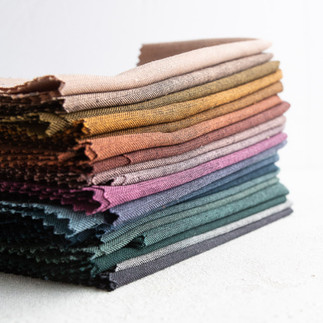Woven Fabrics | Grain : Explained
- Julie Robertson

- Sep 30, 2023
- 3 min read
The term grain when referring to woven textiles refers to the orientation of the weft and warp threads. The three named grains are straight grain, cross grain, and bias grain. Non-woven materials such as felt, interfacing or leather do not have a grain. Sublime Stitchery has a selection of Woven Fabrics which can be found here.
Straight Grain | Warp
The straight grain is oriented parallel with the warp threads and the selvedge. The straight grain typically has less stretch than the cross grain, since the warp threads will be pulled tighter than the weft threads during the weaving process. Most garments are cut with the straight grain oriented top to bottom - keep this in mind when sewing garments from our beautiful Fableism fabrics, garments will tend to hold their shape better and sag less when cut this way.

Cross Grain | Weft
The cross grain runs perpendicular to the selvedge (or, at a right angle to the selvedge) and parallel to the weft threads. The cross grain generally has more stretch than the straight grain because the weft threads are not pulled as taught as the warp threads during the weaving process. Most garments (like pants or shirts) are cut on the straight grain with the cross grain parallel to the floor when the wearer is standing. This allows more stretch through the width of the garment, such as with pant legs which need more circumferential than vertical stretch. Garments are sometimes cut on the cross grain, generally because the pieces are too wide to fit on the straight grain.
Bias
The bias grain of a woven fabric is usually referred to as simply the bias, it is at 45 degrees to its warp and weft threads. Every piece of woven fabric has two biases which are perpendicular to each other (or, at right angles to each other). A garment made of woven fabric is said to be cut on the bias when the fabric's warp and weft threads are at 45 degrees to its major seam lines.
Selvedge
The selvedge of a fabric is the tightly woven edge that runs along each side of the fabric's warp. It is a self-finished edge that prevents it from unravelling and fraying.
Woven fabric is more elastic and has more drape when cut on the bias, compared to the straight and cross grains. This property allows garment designers to incorporate details that require extra elasticity, a more flowing drape or physical flexibility. For quilts and small sewing projects bias cuts are useful for quilt binding, curved edge binding and piping details - they just handle better and give a better visual result.
Projects using Woven Fabrics
Happy Sewing
The straight grain, cross grain, and bias grain each offer unique properties and applications when it comes to creating garments and textile projects. The straight grain provides stability and shape, the cross grain offers stretch and width, and the bias grain adds elasticity and drape.
Whether you're sewing garments or working on quilts and smaller projects, being mindful of grain orientation can greatly impact the outcome of your creations. So next time you embark on a sewing adventure, consider the grain and the creative possibilities they offer in your textile journey. If you're looking for quality woven fabrics to explore these grains, Sublime Stitchery offers a fantastic selection Wovens to help bring your textile visions to life.
Happy sewing!

















Comments